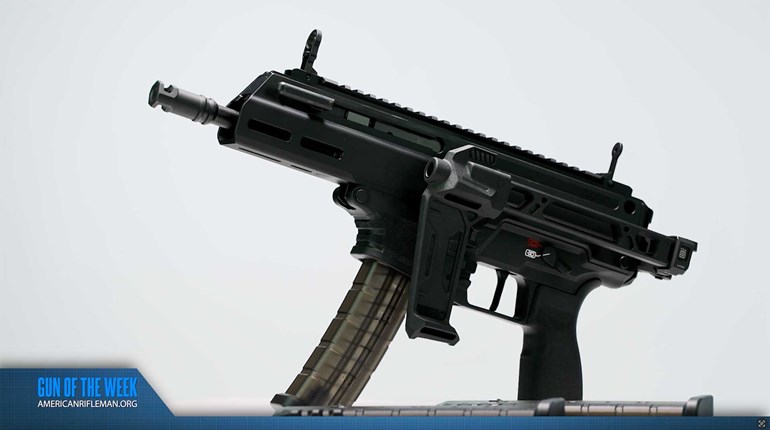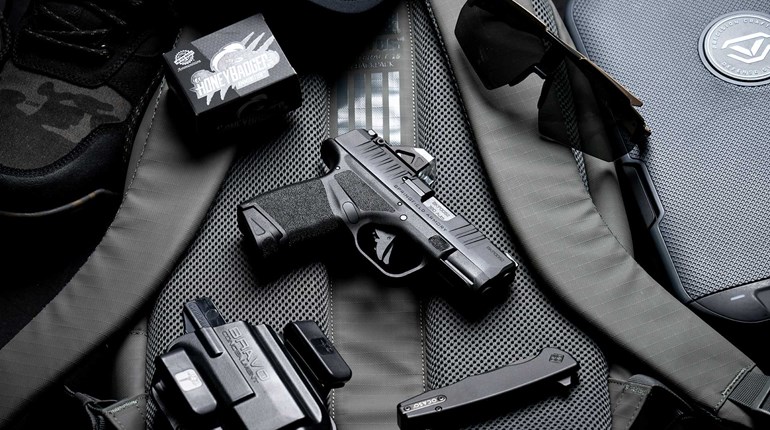
There’s been a steady evolution with Springfield Armory’s product line to the point where the Illinois-based firm is now manufacturing some of the world’s most-advanced firearms geared to personal protectors and tactical shooters. Case in point: the Saint Victor carbine and the Saint Edge pistol.
In all deference to Springfield and its naming system, I feel the Victor carbine and the Edge pistol can be viewed as a related pair based on design and features.
The Saints are the latest AR-15s from Springfield, and they come loaded with features. The barrels are CMV (chrome-moly-vanadium) steel and then given a Melonite treatment inside and out. This provides a harder, more corrosion-resistant surface without the problems chrome-plating can bring. The barrels are both 1/8-inch twist for use with heavyweight bullets.

The forged upper and lower receivers on the carbine, and the forged upper and billet lower on the Edge, are tensioned for a snug fit, by means of the SA Accu-Tite system. So, no wobble. The handguards are free-floated, with M-Lok slots, and, underneath the guards, the gas block is low-profile and pinned in place. No setscrews to work loose and cause gas problems.
Inside their upper receivers, both Saints receive an M16, full-weight carrier and a proof-tested bolt that has been shot-peened for stress reduction. The bolt is composed of 9310 steel (a very good steel for this application), and the complete carrier group has also been Melonite-treated for corrosion resistance and durability. You want mil-spec? This is better than mil-spec.
Inside the lower, the carbine receives a single-stage trigger assembly with all parts treated to a nickel-boron coating. This protects those parts from corrosion and also reduces friction; as a result, the trigger pull on the Saint Victor is clean, crisp and easy to manage. The Edge pistol doesn’t have the boron coating, but the trigger pull is currently an improved single-stage, held in with locking pins.
The carbine’s stock uses a mil-spec-diameter buffer tube. It has a detail I am happy to see: SA properly stakes the receiver plate and castle nut. This is one detail that ought not be overlooked. Some makers do, so Springfield is to be commended for getting it right.

On the buffer tube, Springfield has installed a Bravo Company stock for the Victor. On the Saint Edge pistol, they use a Maxim Defense CQB brace. Both the stock and the brace are adjustable, so guys like me with long arms can fit them to the correct length. For those in California, Springfield offers the Victor with the Strike Industries “featureless” grip, and a fixed Magpul MOE stock. (We mourn for you.) They come with “H”-marked, heavyweight buffers.
Both the Victor and the Edge come with spring-loaded, flip-up iron sights. I used to obsess over iron sights and for a long time searched for the “best” ones. I have given up on that quest because they are all so good now that time is better spent learning to use them. I found the Springfield sights to be just fine, and have no intention of swapping them out for something else.

Also in common, the carbine and the pistol have Bravo Company Gunfighter Mod 3 pistol grips featuring a sharper-than-normal down-angle from the axis of the bore. This does two things. When shooting, it keeps the elbow of your shooting hand down, so you are less likely to be “chicken winging” as you fire. Also, when you are at low ready or bladed down out of ready, your wrist isn’t locked into such a sharp angle. Greater safety when shooting, greater comfort when not.
Now, since the Victor and the Edge are carbine and pistol, respectively, they have some differences. The Bravo Company PKMT handguard on each goes the full length of the barrel, up behind the flash hider mounted at the muzzle. The Edge has a hand stop on the end of the handguard, a good idea since your forward hand is going to be near the noisy end. You wouldn’t want to slip, and the hand stop prevents that. Both have pinned gas blocks, with the Victor featuring a mid-length gas system. The Edge can’t do that, but on it, the gas block is adjustable. Since the barrel is a tidy 10.3 inches long, there isn’t a lot of dwell time for the gas to work in the system before the bullet leaves the muzzle.
I found that out when testing the Edge, and for some reason it would not cycle with light-bullet varmint loads. Luckily, a fellow gun writer was on the next range, testing the Edge he had. His cycled the varmint loads. We pondered it, and then had a light-bulb moment—adjustable gas system. Very useful.
The Victor carbine has a muzzle brake on the end because that is the fashion these days, not because the recoil of .223/5.56 is so vicious. And yes, they are both chambered for 5.56 ammunition. The Edge has a flash hider, as a muzzle brake on a barrel that short would be worse than obnoxious.
Both also have flat-top receivers, so you can readily mount optics of any kind. On the Victor, you might want to go with a 1-4X or 1-6X variable scope. For the Edge, as a compact defensive tool for tight quarters, a red-dot could be a better choice. Not that the Edge can’t reach out (if your skills are up to it), but you are giving up a certain amount of muzzle velocity, what with its 3-inch shorter barrel.
The M-Lok slots allow you to mount an embarrassingly large number of optional items onto the handguard. On both the Victor with its Bravo Company stock, and the Edge, with its Maxim Defense arm brace, you have quick-detach sling swivel sockets. And you should install a sling. Think of a sling as a holster for your rifle (or pistol, in the Edge) and you will be safer.
In test-firing, both the Victor and the Edge—once I had the gas system opened up a bit—cycled 100 percent with all ammo tested. I used a low-power variable on the Victor and a red-dot on the Edge in keeping with my thoughts on defensive and competition use. I’m sure I could have tightened the groups some had I clamped on the 21/2 pounds of 3.5-25X scope I keep on hand for accuracy testing, but that would give you unrealistic expectations. Anyhow, but that size optic, on either the carbine or pistol, would have been unrealistic. And the similarity of the group sizes for the Edge reflects my eyes and a 1X red-dot sight.

What is realistic are their prices. The Victor lists for just a bit over $1,000, and you’ll be able to score one at your local gun shop for less, for sure. The Edge lists at just over $1,500, which is unbelievably reasonable for such a package. Bargain hard enough and you should be able to afford a bunch of practice ammo, which you will probably burn up in your first range session.



































